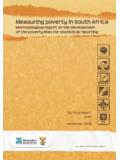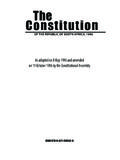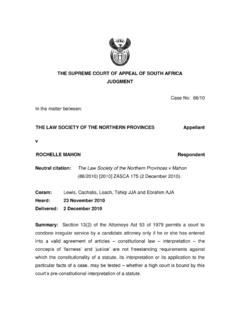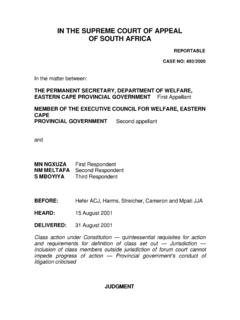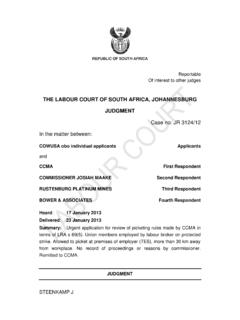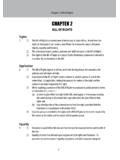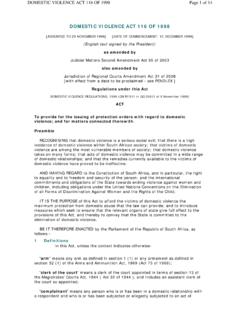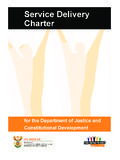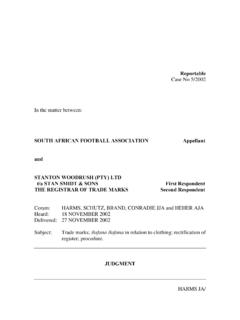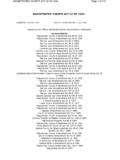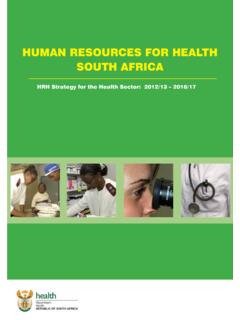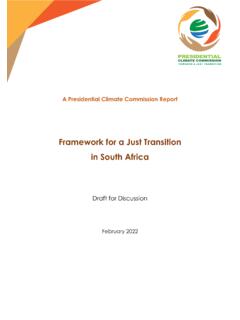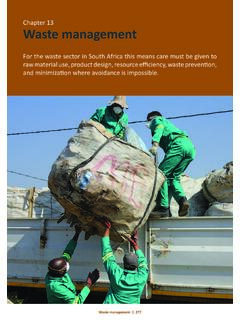Transcription of Truth and Reconciliation Commission of South Africa Report
1 VOLUME ONE Truth andReconciliationCommission of South Africa ReportThe Report of the Truth and Reconciliation Commission waspresented to President Nelson Mandela on 29 October Desmond TutuChairpersonDr Alex BoraineVice-ChairpersonMs Mary BurtonRevd Bongani FincaMs Sisi KhampepeMr Richard LysterMr Wynand Malan*Dr Khoza MgojoMs Hlengiwe MkhizeMr Dumisa NtsebezaDr Wendy OrrAdv Denzil PotgieterDr Fazel RanderaMs Yasmin SookaMs Glenda WildschutChief Executive Officer: Dr Biki Minyuku*Subject to minority position. See Volume 5. CONTENTSC hapter 1 Chairperson s 2 Historical 3 Setting up the Commission ..44 Chapter 4 The : Apartheid as a Crime 5 Concepts and 6 Methodology and 1: Information Management 2: Who Came to theCommission?..165 Chapter 7 Legal Challenges ..174 Chapter 8 The Destruction of 1: Disposal of State 2: Top Management Guidelines Category A 3: Norms for 9 Report of the Chief Executive andAccounting 1: Functional 2: National Hearings, Think Tanks and 3: 4: Foreign 5: Foreign 6: Outside 10 Administrative Reports of StatutoryCommitteesAmnesty Committee.
2 267 Human Rights Violations and Rehabilitation 11 Management and Operational ReportsFinance 1: Audited Financial Statements 1995 2: Audited Financial Statements 1996 3: Donations Resources Department ..319 Information Management and Communication Health Management and Security Protection 12 Regional ReportsCape Town Regional Regional London Regional Regional 13 AddendaApartheid of ChapterONEF oreword by ChairpersonTHE MOST REVD D M TUTU ARCHBISHOP EMERITUS1 All South Africans know that our recent history is littered with some horrendousoccurrences - the Sharpville and Langa killings, the Soweto uprising, the ChurchStreet bombing, Magoo s Bar, the Amanzimtoti Wimpy Bar bombing, the St James Church killings, Boipatong and Sebokeng. We also knew about the deaths indetention of people such as Steve Biko, Neil Aggett, and others; necklacings, andthe so-called black on black violence on the East Rand and in KwaZulu Natal whicharose from the rivalries between IFP and first the UDF and later the ANC.
3 Our country issoaked in the blood of her children of all races and of all political It is this contemporary history - which began in 1960 when the Sharpville disastertook place and ended with the wonderful inauguration of Nelson Mandela as thefirst democratically-elected President of the Republic of South Africa - it is thishistory with which we have had to come to terms. We could not pretend it didnot happen. Everyone agrees that South Africans must deal with that historyand its legacy. It is how we do this that is in question - a bone of contentionthroughout the life of the Commission , right up to the time when this Report wasbeing written. And I imagine we can assume that this particular point will remaincontroversial for a long time to come. ON PREPARING THE Report OF THE Truth AND Reconciliation COMMISSION3 One of the unique features of the South African Commission has been its openand transparent nature.
4 Similar commissions elsewhere in the world have metbehind closed doors. Ours has operated in the full glare of publicity. This meansthat some of the information contained in this Report is already in the publicdomain. Nonetheless, some significant and new insights are included in thepages that The work of the South African Commission has also been far more extensive thanthat of other commissions. The volume of material that passed through our handsVOLUME1 CHAPTER1 Foreword by ChairpersonPAGE1will fill many shelves in the National Archives. This material will be of great valueto scholars, journalists and others researching our history for generations to a research point of view, this may the Commission s greatest The Report that follows tries to provide a window on this incredible resource,offering a road map to those who wish to travel into our past. It is not and cannotbe the whole story; but it provides a perspective on the Truth about a past thatis more extensive and more complex than any one Commission could, in twoand a half years, have hoped to Others will inevitably critique this perspective - as indeed they must.
5 We hopethat many South Africans and friends of South Africa will become engaged inthe process of helping our nation to come to terms with its past and, in sodoing, reach out to a new This Report has been constrained by a number of factors - not least by the extent ofthe Commission s mandate and a number of legal provisions contained in theAct. It was, at the same time, driven by a dual responsibility. It had to providethe space within which victims could share the story of their trauma with thenation; and it had to recognise the importance of the due process of law thatensures the rights of alleged perpetrators. Several court rulings emphasised theimportance of the latter. Obviously, the Commission respected these judge-ments. They did, however, sometimes make our efforts to obtain informationabout the past more difficult. This, in its turn, caused us to err on the side ofcaution in making our findings.
6 Despite these difficulties, however, we can stillclaim, without fear of being contradicted, that we have contributed more to uncov-ering the Truth about the past than all the court cases in the history of There are a number of important points I would like to make before moving to adiscussion of this Report . 9 First, because the Amnesty Committee has not completed its statutory respon-sibilities and will not have done so until it has considered every application foramnesty before it, this Report cannot, strictly speaking, be considered to be the Amnesty Committee has completed its work, the Commission will berecalled to consider the implications of the hearings that have taken place andto add a codicil to the Report . Only at that stage can the Commission s reportbe regarded as CHAPTER1 Foreword by ChairpersonPAGE210 The second point is to stress that, in preparing this Report , we have followedprocedures common to many other national and international commissions.
7 Itwould have been totally impossible for seventeen commissioners to write a singlereport. We have thus leaned very heavily on our Research Department to producedrafts for consideration by commissioners. Further, we have used group methodsand different commissioners have been given responsibilities in respect of differentchapters. The product is thus a joint effort of staff and commissioners, but eachsection was formally adopted by the full Commission in plenary sessions. Thus,the ultimate responsibility for this Report lies with the The third point I would like to make concerns lustration - the disqualification orremoval from public office of people who have been implicated in violations ofhuman rights. The Commission considered this question carefully and finallydecided not to recommend that this step be pursued. It is suggested, however,that when making appointments and recommendations, political parties and thestate should take into consideration the disclosures made in the course of theCommission s Fourth, a few words need to be said about that great difficulty South Africansexperience when describing their fellow compatriots.
8 The former governmentdefined every person according to a racial category or group. Over the years,these became the badges of privilege and of deprivation. For the purposes ofthe Report , the significance of this racial branding is simply that these categoriesare reflected in statistics produced over the years and, in their own way, providea guide to the inequities of the past. 13 From the late 1960s and 1970s, the Black Consciousness Movement campaignedfor the use of the word black to describe all those defined as other than , this was by no means universally accepted and many members of theso-called black group still prefer to be described as coloured, Indian and so debate arises around the term African. Does this or can this refer onlyto black Africans? The debate is not really capable of being resolved. Generallyin this Report , black Africans are referred to as Africans. Coloured people, peopleof Indian or Asian origin and white people are referred to as such.
9 No disrespectis intended to any group or political perspective. It is simply impossible to writea history of South Africa without erring on one side or another of the Finally, every attempt has been made to check, recheck and check again thespelling of the names included in this Report . If there are errors, please forgive us. VOLUME1 CHAPTER1 Foreword by ChairpersonPAGE315 Ultimately, this Report is no more than it claims to be. It is the Report of a commissionappointed by Parliament to complete an enormous task in a limited involved in producing this Report would have loved to have had the timeto capture the many nuances and unspoken truths encapsulated in the evidencethat came before us. This, however, is a task which others must take up and A Dutch visitor to the Commission observed that the Truth and ReconciliationCommission must fail. Its task is simply too demanding. Yet, she argued, even asit fails, it has already succeeded beyond any rational expectations.
10 She quotedEmily Dickinson: the Truth must dazzle gradually .. or all the world would beblind . However, the Commission has not been prepared to allow the presentgeneration of South Africans to grow gently into the harsh realities of the past and,indeed, many of us have wept as we were confronted with its ugly truths. Howeverpainful the experience has been, we remain convinced that there can be nohealing without Truth . My appeal to South Africans as they read this Report isnot to use it to attack others, but to add to it, correct it and ultimately to sharein the process that will lead to national unity through Truth and The past, it has been said, is another country. The way its stories are told and theway they are heard change as the years go by. The spotlight gyrates, exposingold lies and illuminating new truths. As a fuller picture emerges, a new piece ofthe jigsaw puzzle of our past settles into Inevitably, evidence and information about our past will continue to emerge, asindeed they must.
